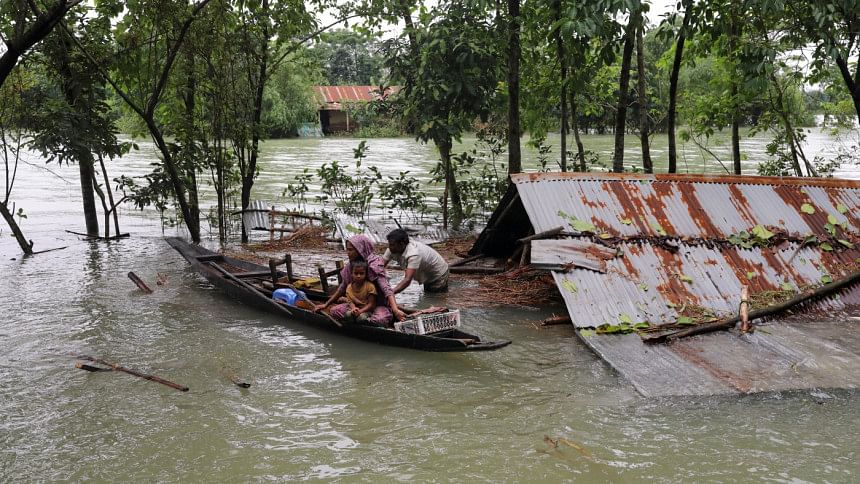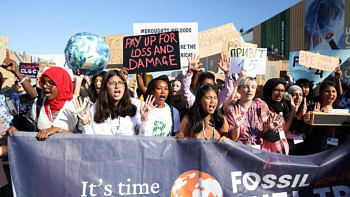COP29 and the stakes for Bangladesh

The 29th Conference of Parties (COP29) to the UN Framework Convention on Climate Change (UNFCCC) will be hosted by Azerbaijan, beginning on November 11. We all understand that COP29 will mainly focus on climate finance. There are reasons for this: no substantive progress has been achieved so far, despite having 11 so-called expert dialogues for the last three-plus years. A new collective quantified goal (NCQG), keeping the long-pledged $100 billion as the floor, is to be agreed by and during COP29. But no silver lining is yet in sight.
The second issue of urgency at COP29 relates to completing the operationalisation of Article 6 of the Paris Agreement, which is about emission reduction through market and non-market mechanisms. Article 6 allows parties to voluntarily enter bilateral or multilateral cooperation as buyers and sellers to implement their nationally determined contributions (NDCs). Such cooperation can take three forms: cooperative approaches that involve the use of internationally transferred mitigation outcomes (ITMO, Article 6.2) in a decentralised manner; use of a centralised mechanism to contribute to GHG mitigation (Article 6. 4), which replaces the Clean Development Mechanism (CDM) under the Kyoto Protocol (both mechanisms must ensure environmental integrity through robust accounting and corresponding adjustments by both buyers and sellers); and non-market approaches (NMAs), under which developing countries can mobilise finance through performance-based implementation of emission reduction policies and programmes, under Article 6.8.
COP26 adopted guidance on cooperative approaches under Article 6.2; rules, modalities and procedures (RMPs) for Article 6.4; and a work programme on NMAs under Article 6.8. However, COPs 27 and 28 failed to complete the operationalisation of Article 6.2 and 6.4 because of differences among parties about the level of transparency and coverage of areas for trading. For example, no decision could be reached yet on the agreed electronic platform (AEP) under Article 6.2. The Azeri Presidency apprears determined to complete the process.
So, it is time for Bangladesh to consider a strategy of negotiation on Article 6. Experience in emissions trading shows Bangladesh as a front-runner among the LDCs, which could mobilise projects under both the Kyoto Protocol and the voluntary carbon market (VCM), which allows industrial country emitters to offset their emissions by purchasing reduction units, called certified emission reduction (CER) from projects in developing countries. The projects in Bangladesh, similar to other LDCs in some regards, involved brick kilns, waste management, clean cooking, control of methane and leakage of gas, and others. Reports show that, unlike in the CDM where LDCs were very marginal—only three percent share of global CERs—they command 37 percent of market share when it comes to VCM.
Why is there this front-runner status of LDCs in VCM? First, sellers from LDCs are induced for short-term gains, as buyers from developed countries are out to get cheap harvest from the LDCs, which are easy to identify and quantify. This will leave for them the higher cost mitigation options in the future. Second, the distribution of benefits is unequal between buyers and sellers, with a layer of intermediaries like project developers, brokers, resellers, funders and consultants creaming off the major share. Third, the process is opaque in terms transparency about who gets what and how much. This was the reason why no consensus on AEP under Article 6.2 could be reached yet. Still, many LDCs entered into such unequal exchanges based on inadequately informed decisions due to weak institutional and individual capacities and knowledge. But emissions trading is perhaps the most complex, technical and knowledge-intensive area.
In actuality, the largely opaque carbon market inhibits a realistic assessment of resources, transferred so far to the LDCs including Bangladesh. A Carbon Market Watch report indicates the market value of LDCs from emissions trading amounted to around $400 million in 2023, where the bulk of projects has been clean cook stoves. But in other developing countries, renewable energy, wind power in particular, formed a major share of the VCM market.
Therefore, the mobilisation potential of finance under carbon market is measly compared to other flows such as overseas development aid (ODA).
There could be other negatives in carbon trading as well, affecting the LDCs. Investment in mitigation, which is already more than adaptation even in LDCs, may create additional incentive for buyer countries to further redirect ODA towards Article 6.2 activities, scaling their relabelling as climate finance in coming years. Also, the exemption of five percent of levy from projects under Article 6.4 in the LDCs and SIDS (Small Island Developing States) may be viewed as an additional contribution of donors for adaptation. This might be true only if such exempted levies are deposited directly into their national adaptation funding mechanisms. But, participation in carbon markets may contribute better to structural transformation of our economies if more projects are initiated in renewable energy and energy efficiency areas.
It is encouraging that in late June this year, the Bangladesh government issued a notification for establishing a National Designated Authority (NDA) on Article 6, to develop the required policy-institutional framework and build capacity for carbon pricing and emissions trading. Additionally, there are a number of projects, such as the joint crediting mechanism, with Japan or the World Bank supported Partnership for Market Implementation. These projects will contribute to a learning by doing process as well.
So, my final suggestion is to have a cautionary approach, with a "wait and see" policy. Negotiations on Article 6 are not yet complete. Currently, the average price per CER (one metric tonne) is below $10. Once Article 6 is fully operationalised, demand for CERs may push the price up by several times. In the meantime, our newly established NDA could design appropriate frameworks and build capacity, while the private sector may lead in project development with external partners.
Mizan R Khan is a board member at Scientific Council of COP29 Presidency, visiting scholar at Brown University, and technical lead at LDC Universities Consortium on Climate Change (LUCCC).
Views expressed in the article are the author's own.
Follow The Daily Star Opinion on Facebook for the latest opinions, commentaries and analyses by experts and professionals. To contribute your article or letter to The Daily Star Opinion, see our guidelines for submission.

 For all latest news, follow The Daily Star's Google News channel.
For all latest news, follow The Daily Star's Google News channel. 








Comments